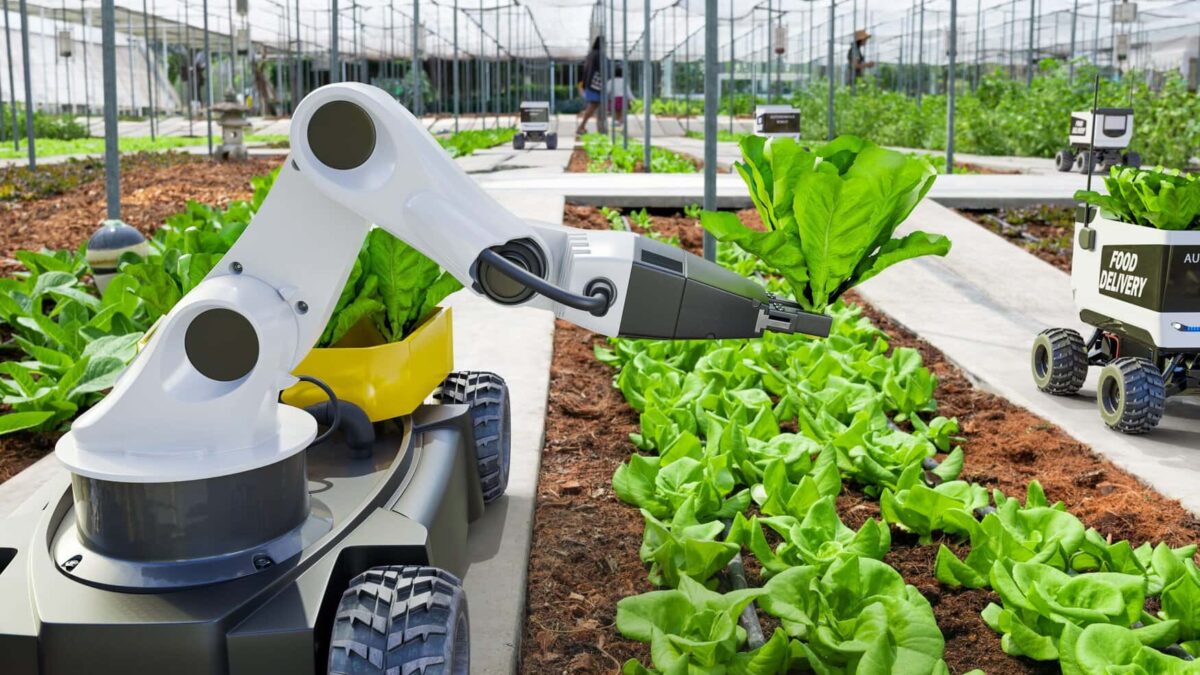Table of Contents
Introduction
The shift towards automation in agriculture is no longer a distant vision; it is a reality reshaping the sector in profound ways. The implementation of robotics in agricultural practices is designed to address various challenges, including labor shortages, climate variability, and the urgent need for food security amidst a growing global population. As traditional farming methods face pressures to evolve, robotics provides innovative solutions with the potential to significantly enhance productivity, efficiency, and sustainability in food production. This article will explore the transformative role of robotics in agriculture, focusing on their types, benefits, challenges, and the future landscape of farming.
Robotics in Agriculture
Robots are being used more in agriculture to improve the efficiency of farming. These technologies help solve challenges like labor shortages, unpredictable weather, and the growing demand for food. By working alongside farmers, robots improve farming practices, boost food production, and reduce environmental harm.
The main goal of using robots in farming is to increase productivity by getting more crops per acre. Robots help farmers make smarter decisions with precise techniques and automation, saving time on tasks like planting, monitoring crops, and harvesting.
Robots also promote more sustainable farming by using less fertilizer and pesticides. This helps reduce harm to the environment. With the world’s population expected to reach over 9 billion by 2050, robotics will be key to ensuring food security and better resource use.
Key Goals of Robotics in Agriculture
- Increase Productivity: More crops per acre by optimizing farming.
- Boost Efficiency: Robots save time and resources on tasks.
- Support Sustainability: Robots help reduce chemical use, supporting cleaner farming practices.
Types of Agricultural Robots
The agricultural industry has seen a rise in robots designed to help with various farming tasks. These robots are built to handle different aspects of farming, from planting to harvesting and crop monitoring. Here are several common types of robots used in agriculture:
- Autonomous Tractors: Autonomous tractors are driverless machines used for tasks such as tilling, planting seeds, and harvesting crops. They operate without a human driver and use sensors and GPS for better efficiency. An example is Case IH’s autonomous tractor.
- Drones: Drones are used for monitoring crops from the air. They provide real-time information about plant health, soil conditions, and pests. For instance, Precision Hawk’s drones help farmers survey crops and apply treatments where needed.
- Robotic Harvesters: These robots automate the process of picking fruits and vegetables. The FFRobotics harvester, for example, uses computer vision to pick fruits carefully, reducing waste and cutting down labor costs.
Read Also: Smart Technology in Urban Farming: The Future of Food Production
Benefits of Implementing Robotics in Agriculture
Using robotics in farming brings several key benefits that can transform agricultural practices, improve food production, and support environmental sustainability.
- Labor Cost Reduction: Robots help reduce the need for manual labor, especially during peak seasons. By automating routine tasks, farmers can focus on more important jobs, cutting down on overall labor costs.
- Increased Precision and Accuracy: Robots can analyze data and perform tasks more accurately. For example, companies like Blue River Technology use robots to target weeds and apply treatments only where needed, improving crop yields and produce quality.
- Environmental Sustainability: Robots help farmers use water, fertilizers, and pesticides more efficiently, reducing waste and environmental harm. This method leads to healthier crops and supports the growing demand for sustainably grown food.
Challenges in Robotics Adoption
Although robotics in agriculture offers many benefits, there are several challenges that farmers face when adopting this technology.
- High Initial Investment: Robotic systems can be expensive, which may be a barrier for smaller farms. Unlike traditional equipment, the cost of advanced robots and drones can be high, making farmers hesitant to invest without a clear understanding of the return on investment (ROI).
- Technological Resistance: Some farmers, especially in developing areas, may resist robotics because they lack knowledge or fear the technology will take away jobs. Educating farmers and offering training programs can help ease these concerns and encourage the adoption of robotics in farming.
- Technical Maintenance: Robots require regular maintenance and technical expertise to keep them running smoothly. Farmers need access to training and support to properly maintain these machines, which can be challenging as they transition to more advanced farming methods.
Conclusion
The role of robotics in revolutionizing agriculture is both profound and transformative, providing solutions to some of the most pressing challenges in food production. By enhancing productivity, efficiency, and sustainability, robotic systems are poised to shape the future of farming. As the industry continues to evolve, addressing the challenges impeding the widespread adoption of agricultural robotics will be crucial. By fostering innovation and embracing technological advancements, the agricultural sector can move towards a more productive and sustainable future, ensuring food security for generations to come.
FAQs
- What are the primary benefits of using robotics in agriculture?
Robotics offers numerous advantages including increased productivity, labor cost reduction, enhanced precision in farming practices, and sustainable agricultural techniques that minimize environmental impact. - How do autonomous tractors operate?
Autonomous tractors are equipped with advanced sensors and GPS technology that allow them to navigate fields and perform tasks such as tilling, planting, and harvesting without human intervention. - What types of crops can robotic harvesters pick?
Robotic harvesters are designed to pick a variety of fruits and vegetables, with developers creating systems tailored for specific crops such as strawberries, apples, and tomatoes, thus streamlining the harvesting process. - What obstacles do farmers encounter when integrating robotic technologies?
Farmers may encounter challenges such as high initial investment costs, technological resistance, and the need for ongoing technical maintenance and training to effectively integrate robotics into their operations. - How does precision agriculture benefit from robotics?
Precision agriculture utilizes robotics to apply resources like water, fertilizers, and pesticides accurately, reducing overall usage and minimizing the environmental footprint while maximizing crop yield.





